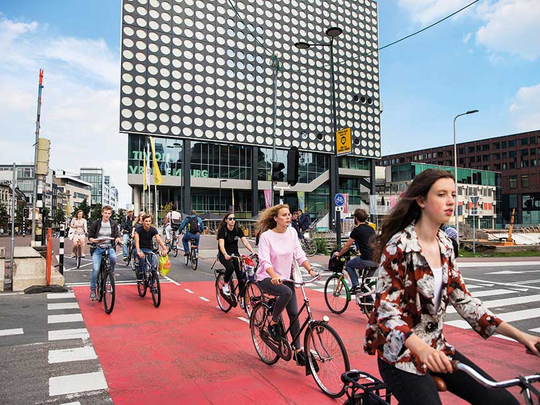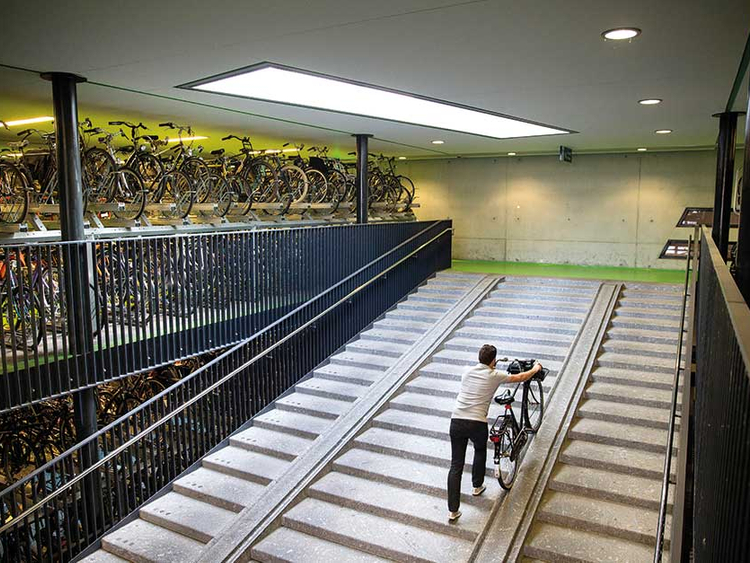
UTRECHT, Netherlands: When city officials unveiled the first section of the world’s largest bike parking garage in Utrecht, this small city in the centre of the Netherlands, late last month, the feeling of accomplishment was short-lived.
While many of the 6,000 new, state-of-the-art bike parking spots filled quickly, city engineers focused on the work ahead: creating thousands more such spots and hundreds more miles of bike paths to ensure that even more Utrecht residents can comfortably commute by bike.
“We found that if you build it, people will use it,” said Lot van Hooijdonk, a vice mayor, about her city’s seemingly insatiable public demand for bike infrastructure.
Utrecht, with 330,000 residents, is the Netherlands’ fourth-largest and fastest growing city. It is also one of the most bike-friendly places in one of the world’s most bike-friendly countries.
The city recently replaced Amsterdam in a widely respected ranking of bike-friendly cities, and is second only to Copenhagen, Denmark, which is more than twice its size.
“What the Danes and the Dutch do now is what people in most cities in the world did for decades,” said Mikael Colville-Andersen, an urban design expert and CEO of Copenhagenize Design Co., which releases the biennial index of bike-friendly cities.
Elsewhere in the Netherlands, more than a quarter of all trips are made by bicycle, and the federal government has been building up its bike infrastructure over the last decade, despite cuts in other sectors.
The yearly investment of roughly 500 million euros (Dh2.2 billion), proponents say, pays for itself by reducing health, social and other costs.
The increased infrastructure has led to an increase in people using their bikes daily, and contributes to the reduction of road accidents for cars and bikes.
While promoting biking used to be an issue for more progressive political parties, recent successes have made it one of broad agreement in mainstream politics.
“All politicians now take cycling seriously,” said Mark Wagenbuur, a well-known blogger and bike activist.
In a country where there are more bikes than people — 22.5 million vs. 18 million — daily usage has grown by 11 per cent in the last decade, mostly because of the introduction of electric bikes, which lengthens the time many older people can use two-wheel transportation.
Deadly bike accidents have decreased, by 21 per cent, over the last two decades, according to state figures. Much of that is attributed to less competition with motor vehicles — the more people ride, the safer it gets.
More important for the nation’s bottom line, the country’s preference for the bicycle could save its economy 19 billion euros each year, according to a recent study done at Utrecht University and published in the American Journal of Public Health. The study suggested that the Netherlands’ vigorous cycling habits prevented 6,500 premature deaths each year.
“Biking saves medical costs since it contributes to people’s overall physical activity levels, and getting sufficient physical activity prevents against many noncommunicable diseases, including obesity, type 2 diabetes, coronary heart disease and some types of cancers,” wrote Dr Carlijn Kamphuis, the study’s lead author, in an email exchange.
Frans Jan van Rossem, Utrecht’s head of bicycle programming, put it another way. “Our revenue is healthy people, less traffic and beautiful living,” he said.
Under Van Rossem’s watch, the city has expanded its bike network and has made innovations that have brought the average number of daily bike trips to 125,000. The city estimates these are worth an estimated 250 million euros in socioeconomic benefits that include health care savings, reduced air pollution and increased productivity.
“It didn’t fall from the cold blue sky,” said Van Hooijdonk, the vice mayor, whose yearly city budget includes an average 46 million euros for bike infrastructure projects and improvements.
Not everyone, though, thinks the battle is won. Milieudefensie, a crowdfunded group of environmentalists, took the federal government to court last month over air quality, which it says is far below that called for by the European Union.
Utrecht, like many other European cities, spent several postwar decades trying to make automobile use easier.
The effort included building a four-lane highway over centuries-old canals, making space for parked cars on its narrow cobblestone streets, and planning for a highway that was to cross the medieval city’s cathedral square.
Decades later, the concept of progress looks quite different.
At Dafne-Schippers, a new elementary school named for the Dutch sprinter, the green roof serves as an access ramp to a 110-metre bicycle and pedestrian bridge that crosses the Amsterdam Rhine canal, a major water thoroughfare. Yet children playing recently during recess hardly seemed to notice the steady stream of cyclists.
A 15-minute bike ride from City Hall (which, like all other newly built buildings has its own biking garage — this one for 1,650 bikes), a small startup, Springlabs, is trying to perfect a device that tells bikers how hard to pedal to catch the next green light.
“Cities want to innovate, said Jan-Paul de Beer, the company’s director. They want to do new stuff to make the cycling experience even better.”
His traffic control system, Flo, is being tested in Utrecht, Eindhoven and soon in Antwerp, Belgium.
Finding bike parking in Utrecht’s medieval downtown can be made easier by a smartphone app or a glance at the large digital street signs that show those garages with empty bike parking spots.
“These old cities weren’t made for cars,” Wagenbuur said.
Utrecht’s cycling network includes nearly 400km of dedicated bike lanes. Large signs alert car drivers that they are merely guests on these roads, and should limit their speed to less than 20 mph.
Besides its sheer size, the Utrecht Central station biking garage boasts several innovations. Cyclists can check in and find their spot while riding their bikes. Sensors on the racks give real-time information, making finding a free spot during rush hour much easier.
The project’s cost, 40 million euros, was paid not just by the municipality, but also by the region and the national train service, which recognises that increasing the availability of bike parking leads to an increase in riders.
“Cycling is like a piece of magic: It only has advantages,” said Van Hooijdonk, who like the majority of Utrecht’s residents commutes to work by bike.













